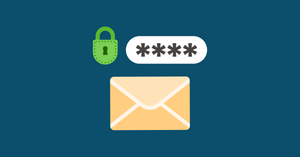Do you need to send a confidential email? Maybe you want to keep your boss's email address private, or you need to send an invoice to a client. Whatever the reason, password-protected emails can come in handy.
This article will show you how to send a password protected email in Gmail. It’s quick, easy, and, best of all, free!
Here’s a brief overview of what you’ll need to do:
- Go to Gmail.
- Click Compose.
- Turn on confidential mode
- Set an expiration date and passcode
- Click Save.
Let’s get started!
Steps to password protect an email
Step 1: Go to Gmail and click ‘Compose’
The first step is to go to your Gmail account and click on the 'Compose' button, which can be found in the top left-hand corner of the screen.
Step 2: Turn on the Gmail Confidential Mode
Once you've clicked 'Compose', a new email window will open up. You'll need to use Gmail's ‘’Confidential Mode’’ to send an email with a passcode.
So, what is the confidential mode in Gmail? The Confidential mode in Gmail is a feature that helps you keep your messages safe by preventing the recipient from forwarding, copying, printing, or downloading your email.
In the bottom right-hand corner of this window, you'll see a small lock icon – click on this to turn on the Gmail Confidential Mode.
Step 3: Set an expiration date and passcode
With Confidential Mode turned on, you can now set an expiration date for the email, as well as a passcode that the recipient will need to enter to read the email.
There are five expiration date options to choose from: 1 day, 1 week, 1 month, 3 months, or 5 years.
As for the passcode, you have the options "No SMS passcode," and "SMS passcode."
If you choose the former, and the recipient has a Gmail account, they’ll be able to open it directly. If they use another email service, they’ll receive a Gmail passcode over email.
If you choose the latter, the passcode will be sent to the recipient's phone via text message. Make sure to type in theirs, not yours!
Step 4: Click ‘Save’
Once you've entered the expiration date and passcode, click on the 'Save' button in the bottom right-hand corner of the screen.
Step 5: Write your email and click 'Send'
With your Confidential Mode settings enabled, go ahead and enter your recipient's email address into the 'To' field.
You can now write your email as normal. However, remember that because Confidential Mode is turned on, any attachments you add will also be subject to the expiration date and passcode settings.
When you're finished, click 'Send' and your email will be on its way!
Accidentally sent an email? Learn how to retract an email in gmail here
Remove access early
If you need to, you can remove access to an email before its expiration date.
To do this, simply go to the 'Sent' folder in Gmail. Then open up the confidential email, and click on the 'Remove Access' button in the bottom right-hand corner.
Now, the email will no longer be accessible to the recipient. This includes any attachments. The passcode that was provided will no longer work as well.
Important notes about password-protected emails in Gmail
Opening password-protected emails
When you receive a password-protected email, you will need to enter the Gmail passcode to open it. The passcode will be sent to your phone via text message (if the sender has chosen this option) or your email if you have a different email service.
If you use a different email service, open the email and click “View the email.” You’ll then have to provide your Google credentials.
To receive your passcode over text, select “Send passcode” on the email. You’ll then get a text with it, and you can enter it into the email to view its contents.
Potential errors with password-protected emails
If you're having trouble opening a password-protected email in Gmail, there are a few things you can try:
- Check the expiration date: If the email has an expiration date, make sure it hasn't passed yet. If it has, contact the sender to see if they can send you a new email.
- Switch accounts: If you have more than one Google Account, make sure you're signed in to the account that the email was sent.
- The provided number is for an unsupported country: The sender may have included a phone number in their email that's only available in a country that Gmail doesn't support. Only phone numbers from Europe, the United States, Australia, and Asia (India, Korea, and Japan) are currently supported.
Those are a few potential solutions to try if you're having trouble opening a password-protected email in Gmail. Hopefully one of them will work for you!
Emails are not end-to-end encrypted by default
If emails are not end-to-end encrypted, it means that the email is still stored in the servers of the email service providers and can still be accessed. This means that if you don’t know how to encrypt an email in Gmail, your personal and sensitive information could be compromised.
To help protect your privacy, you can enable end-to-end encryption for your email service. This ensures that only the sender and recipient of the email can read the contents of the message.
Gmail offers this in the form of S/MIME encryption. This is highly technical, but if you’re interested in learning how to encrypt your emails in Gmail this way, they offer a guide. You can always check the encryption status of your email by checking the encryption icons.

